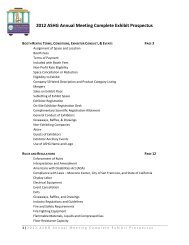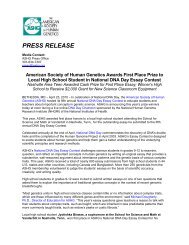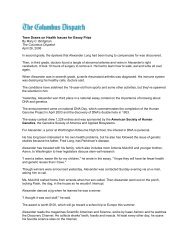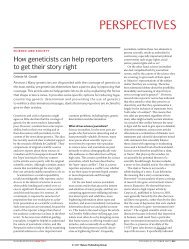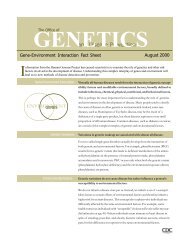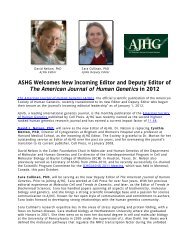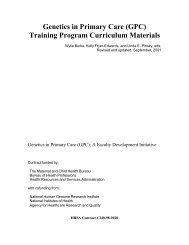ASHG Statement on Professional Disclosure of Familial Genetic ...
ASHG Statement on Professional Disclosure of Familial Genetic ...
ASHG Statement on Professional Disclosure of Familial Genetic ...
You also want an ePaper? Increase the reach of your titles
YUMPU automatically turns print PDFs into web optimized ePapers that Google loves.
<str<strong>on</strong>g>ASHG</str<strong>on</strong>g> Subcommittee <strong>on</strong> <strong>Familial</strong> <strong>Disclosure</strong>: <str<strong>on</strong>g>ASHG</str<strong>on</strong>g> <str<strong>on</strong>g>Statement</str<strong>on</strong>g> 477<br />
mati<strong>on</strong>, albeit with special c<strong>on</strong>cerns and implicati<strong>on</strong>s. 4<br />
Even those who believe that genetic informati<strong>on</strong> cannot<br />
be easily distinguished from other medical informati<strong>on</strong><br />
note that “genetic informati<strong>on</strong> does not have to be completely<br />
unique in order to warrant special protecti<strong>on</strong>”;<br />
it simply has to be treated as “distinctive and especially<br />
sensitive.” 5 Moreover, genetic excepti<strong>on</strong>alism <strong>on</strong>ly<br />
strengthens the noti<strong>on</strong>s <strong>of</strong> genetic determinism and genetic<br />
reducti<strong>on</strong>ism (Murray 1997).<br />
The c<strong>on</strong>tagious-disease model, <strong>of</strong>ten cited in discussi<strong>on</strong>s<br />
<strong>of</strong> potential duties to warn at-risk relatives, is not<br />
an ideal paradigm for the disclosure <strong>of</strong> genetic informati<strong>on</strong>.<br />
First, genetic c<strong>on</strong>diti<strong>on</strong>s are inherited—transmitted<br />
vertically through succeeding generati<strong>on</strong>s—and<br />
the c<strong>on</strong>necti<strong>on</strong>s are solely dependent <strong>on</strong><br />
biological relati<strong>on</strong>s. C<strong>on</strong>versely, c<strong>on</strong>tagious disease is<br />
generally transmitted horiz<strong>on</strong>tally (save for parent-<strong>of</strong>fspring<br />
transmissi<strong>on</strong>), and its impact <strong>on</strong> others occurs<br />
through some form <strong>of</strong> c<strong>on</strong>tact. Finally, c<strong>on</strong>tagious disease<br />
is c<strong>on</strong>trolled by isolati<strong>on</strong> <strong>of</strong> affected people, by<br />
avoidance <strong>of</strong> whatever c<strong>on</strong>tact causes infecti<strong>on</strong>, or by<br />
cure. <strong>Genetic</strong> c<strong>on</strong>diti<strong>on</strong>s, <strong>on</strong> the other hand, are c<strong>on</strong>trolled<br />
not <strong>on</strong>ly through preventi<strong>on</strong> or palliative treatment<br />
but also through reproductive decisi<strong>on</strong>s and<br />
choices (adopti<strong>on</strong>, reproductive technologies, etc.).<br />
We will now examine, in brief, the various ethical,<br />
legal, and internati<strong>on</strong>al c<strong>on</strong>texts with regard to the issue<br />
<strong>of</strong> disclosure <strong>of</strong> genetic informati<strong>on</strong> to at-risk family<br />
members. We will not, however, c<strong>on</strong>sider the particulars<br />
<strong>of</strong> disclosure to minors; to spouses, for the purposes <strong>of</strong><br />
4<br />
This issue has been addressed specifically in the literature, with<br />
regard to legislati<strong>on</strong> c<strong>on</strong>cerning genetic informati<strong>on</strong>. See Reilly (1997),<br />
who ultimately determines that, since genetic informati<strong>on</strong> will (in the<br />
not-too-distant future) become a standard part <strong>of</strong> the general medical<br />
record, laws that protect the privacy <strong>of</strong> all individual medical records,<br />
as opposed to laws that regulate genetic informati<strong>on</strong> specifically, are<br />
required. He notes that the Medical Records C<strong>on</strong>fidentiality Act <strong>of</strong><br />
1995 (s. 1360, 104th C<strong>on</strong>g., 1st sess., sec. 2[1]), for example, presents<br />
a reas<strong>on</strong>able general approach to medical informati<strong>on</strong> and that it<br />
would be comprehensive if “genetic informati<strong>on</strong>” were added to its<br />
list <strong>of</strong> protected entities. See also Gostin (1995), who notes that the<br />
enactment <strong>of</strong> genetic-specific privacy legislati<strong>on</strong> could create inc<strong>on</strong>sistencies<br />
in the rules that govern the disseminati<strong>on</strong> <strong>of</strong> health informati<strong>on</strong><br />
and that, since “the flow <strong>of</strong> medical informati<strong>on</strong> is rarely restricted to<br />
particular diseases or c<strong>on</strong>diti<strong>on</strong>s,” “comprehensive legislati<strong>on</strong> <strong>on</strong><br />
health informati<strong>on</strong> privacy, with explicit language applying privacy<br />
and security standards to genomic informati<strong>on</strong>” would be a better<br />
alternative. See also Knoppers (1997).<br />
5<br />
See Murray (1997, pp. 60–73). Murray rejects unique distincti<strong>on</strong>s<br />
between genetic informati<strong>on</strong> and other medical informati<strong>on</strong> and notes,<br />
inter alia, that cholesterol levels are probabilistic informati<strong>on</strong>, that<br />
other medical informati<strong>on</strong> affects the family (although sensitivity may<br />
be amplified with genetic informati<strong>on</strong>), and that discriminati<strong>on</strong> occurs<br />
with n<strong>on</strong>genetic informati<strong>on</strong>—as, for example, in the insurance<br />
industry.<br />
making informed reproductive choices 6 ; or to at-risk relatives<br />
who have the same family physician as the<br />
patient. 7<br />
V. C<strong>on</strong>texts<br />
A. Ethical C<strong>on</strong>siderati<strong>on</strong>s<br />
The c<strong>on</strong>cept <strong>of</strong> privacy has evolved, from a right <strong>of</strong><br />
privacy, to a pers<strong>on</strong>al right to be left al<strong>on</strong>e and, ultimately,<br />
to a fundamental right that is based <strong>on</strong> human<br />
dignity and respect for the individual—the latter noti<strong>on</strong><br />
being understood in terms <strong>of</strong> self-determinati<strong>on</strong> (Knoppers<br />
et al. 1995; LeBris and Knoppers 1997). Privacy<br />
rights, in the c<strong>on</strong>text <strong>of</strong> medical informati<strong>on</strong>, translate<br />
into protecti<strong>on</strong> <strong>of</strong> pers<strong>on</strong>al data and affirmati<strong>on</strong> <strong>of</strong> c<strong>on</strong>fidentiality.<br />
As such, genetic informati<strong>on</strong> is protected by<br />
the legal and ethical principle <strong>of</strong> c<strong>on</strong>fidentiality that exists<br />
within the health-care pr<strong>of</strong>essi<strong>on</strong>al–patient relati<strong>on</strong>ship.<br />
There is a comm<strong>on</strong>ly held view that, without an<br />
expectati<strong>on</strong> <strong>of</strong> c<strong>on</strong>fidentiality, patients will be less forthcoming<br />
in disclosing sensitive pers<strong>on</strong>al informati<strong>on</strong>.<br />
C<strong>on</strong>fidentiality, however, is not absolute. Codes <strong>of</strong><br />
medical ethics permit physicians, in excepti<strong>on</strong>al cases,<br />
to disclose otherwise c<strong>on</strong>fidential informati<strong>on</strong>. 8 Four<br />
ethical positi<strong>on</strong>s regarding a health-care pr<strong>of</strong>essi<strong>on</strong>al’s<br />
duty or privilege to warn at-risk relatives about genetic<br />
informati<strong>on</strong> are found in the literature.<br />
In the traditi<strong>on</strong>al health-care pr<strong>of</strong>essi<strong>on</strong>al–patient relati<strong>on</strong>ship,<br />
c<strong>on</strong>fidentiality is absolute. All medical informati<strong>on</strong><br />
is strictly private. Health-care pr<strong>of</strong>essi<strong>on</strong>als are<br />
obliged to inform patients about the implicati<strong>on</strong>s <strong>of</strong> their<br />
genetic test results and about the potential risks to family<br />
members. However, c<strong>on</strong>fidentiality prevents the healthcare<br />
pr<strong>of</strong>essi<strong>on</strong>al from disclosing any genetic informati<strong>on</strong><br />
to relatives; the health-care pr<strong>of</strong>essi<strong>on</strong>al has a duty<br />
not to breach c<strong>on</strong>fidentiality. From this viewpoint, it<br />
would be unethical to do so.<br />
Alternatives to this strict view <strong>of</strong> health-care pr<strong>of</strong>es-<br />
6<br />
The issue <strong>of</strong> disclosure to spouses is c<strong>on</strong>troversial; although there<br />
may be no pers<strong>on</strong>al risk to the spouse, genetic test results are pertinent<br />
for the purposes <strong>of</strong> making informed reproductive choices. The Institute<br />
<strong>of</strong> Medicine (1994) recommended that health-care pr<strong>of</strong>essi<strong>on</strong>als<br />
not reveal genetic informati<strong>on</strong> about a patient’s carrier status to the<br />
patient’s spouse, without the patient’s permissi<strong>on</strong>, since a spouse’s<br />
claim <strong>of</strong> harm—the possibility <strong>of</strong> bearing a child with a genetic disorder—could<br />
not be c<strong>on</strong>sidered substantial and imminent.<br />
7<br />
This issue raises the questi<strong>on</strong> <strong>of</strong> whether the family physician’s<br />
obligati<strong>on</strong> to disclose is greater given that the physician may already<br />
be treating relatives <strong>of</strong> the patient.<br />
8<br />
Note that the code <strong>of</strong> ethics <strong>of</strong> the Canadian Medical Associati<strong>on</strong><br />
(1996) permits a breach <strong>of</strong> a patient’s right to c<strong>on</strong>fidentiality, inter<br />
alia, “when the maintenance <strong>of</strong> c<strong>on</strong>fidentiality would result in a significant<br />
risk <strong>of</strong> harm to others” (article 22). In c<strong>on</strong>trast, the code <strong>of</strong><br />
ethics <strong>of</strong> the American Medical Associati<strong>on</strong> (1996) does not refer to<br />
risk <strong>of</strong> harm but restricts itself to “disclosure need[ed] to protect the<br />
welfare <strong>of</strong> the individual or the public interest.”




